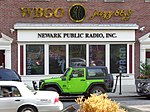Aureole (restaurant)
2020 disestablishments in New York (state)42nd Street (Manhattan)Defunct Michelin Guide starred restaurants in ManhattanDefunct New American restaurants in New York (state)New American restaurants in New York City ... and 2 more
New York City restaurant stubsRestaurants disestablished in 2020
Aureole was a restaurant in New York City. The restaurant served American / New American cuisine. The restaurant closed in 2020 after operating for 32 years.
Excerpt from the Wikipedia article Aureole (restaurant) (License: CC BY-SA 3.0, Authors).Aureole (restaurant)
West 42nd Street, New York Manhattan
Geographical coordinates (GPS) Address Nearby Places Show on map
Geographical coordinates (GPS)
| Latitude | Longitude |
|---|---|
| N 40.755555555556 ° | E -73.985277777778 ° |
Address
Bank of America Tower
West 42nd Street 115
10036 New York, Manhattan
New York, United States
Open on Google Maps






